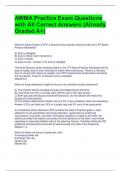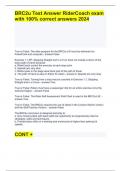AWMA Practice Exam Questions
with All Correct Answers (Already
Graded A+)
Which of these choices is NOT a fiduciary duty explicitly required under the CFP Board
Practice Standards?
A) Duty to delegate
B) Duty to follow client instructions
C) Duty of loyalty
D) Duty of care - Answer ✔ A) Duty to delegate
The three fiduciary duties explicitly stated in the CFP Board Practice Standards are the
duty of loyalty, duty of care, and duty to follow client instructions. There is a fiduciary
duty to consult with others as needed, and CFP professionals as fiduciaries should do
this as needed. There is no fiduciary duty to delegate.
Module 8-5
Which of these statements might be found in an investment policy statement?
A) The portfolio will be reviewed annually and rebalanced at that time.
B) Loss limits are 15% in a single year and 5% over a five-year period.
C) Both spouses will discuss investment decisions, but the adviser will make final
decisions for the portfolio.
D) The adviser-determined inflation rate is 2.4%, to be reviewed if rates are increasing. -
Answer ✔ B) Loss limits are 15% in a single year and 5% over a five-year period
An investment policy statement (IPS) contains the client's financial goals, a clear
statement of risk parameters and asset allocation, agreement on underlying
assumptions, loss limits, and other information decided on solely by the client. An
adviser provides information, but leaves the final decisions to the client, even those
regarding an assumed inflation rate for the planning horizon. Portfolios follow the IPS
guidelines and should be reviewed at least annually and often more frequently.
Module 1-4
Which of these are forms of systematic risk?
Purchasing power risk
Exchange rate risk
Default risk
Market risk
,A) I and II
B) II and III
C) I only
D) I, II, and IV - Answer ✔ D) I, II, and IV
Recall the P.R.I.M.E. acronym for systematic (or nondiversifiable) risk: Purchasing
power, Reinvestment, Interest rate, Market, and Exchange rate risks. Options I, II, and
IV are elements of the P.R.I.M.E. acronym, while III (default) is a form of unsystematic
(or diversifiable) risk
Module 2-1
What behavioral finance bias explains the tendency of individuals to attach more value
to an asset they own rather than one that they may be interested in purchasing?
A) Endowment
B) Framing
C) Illusion of control
D) Rationalization - Answer ✔ A) Endowment
The endowment bias is when individuals value an owned asset more than those that
are not owned. One result is the tendency to demand a higher price when selling an
asset, and requiring a lower price to purchase an asset.
Module 3-3
Which of these is a characteristic of retirement income benefits received from a defined
contribution plan?
A) Determinable in advance
B) Specified in the plan document
C) Fixed once distributions begin
D) Variable depending upon several factors - Answer ✔ D) Variable depending upon
several factors
Defined contribution plans typically provide for an employer contribution but, unlike
defined benefit plans, do not specify the benefit that will be paid from the plan. The
amount of a participant's retirement benefit is based on the value of the participant's
account balance at retirement. In a defined contribution plan, each participant's plan
funds are maintained in an individual account.
Module 4-2
Kristen received 500 shares of stock as a gift from her Aunt Ethel. Ethel purchased the
stock 11 years ago for $100,000. Kristen received the stock from Aunt Ethel nine
months ago, when the fair market value was $110,000, and she sold the stock this week
for $150,000. What is the amount and character of Kristen's gain from the sale of the
stock?
,A) $40,000 short-term capital gain
B) $40,000 long-term capital gain
C) $50,000 short-term capital gain
D) $50,000 long-term capital gain - Answer ✔ D) $50,000 long-term capital gain
In the case of an asset received as a gift, where the fair market value on the date of the
gift is greater than the donor's adjusted basis, the recipient has a carryover basis. In this
case, Aunt Ethel had purchased the stock for $100,000 and gifted it to Kristen when the
fair market value was $110,000. Kristen subsequently sold the stock for $150,000.
Thus, the carryover basis from Aunt Ethel would be $100,000. In a situation where the
recipient of the gift takes the donor's basis, the holding period is "tacked." In other
words, the donor's holding period is added to the donee's holding period. Thus, Kristen
is treated as holding the stock for over 11 years.
Module 5-5
Kevin, a 56-year-old corporate executive, wants advice as to when he can retire. His
current salary is $240,000 and he receives an annual bonus of $300,000; he also has
annual stock options and restricted stock awards valued at $100,000. His employer
contributes to a cash balance pension plan and matches his contributions to a 401(k).
Kevin owns a whole life insurance policy with a $500,000 death benefit and is
considering the purchase of a term policy with a $2 million death benefit. He and his
wife, Anne, age 55, believe they can live on an after-tax income of $180,000. Assume a
federal income tax rate of 32%.
Kevin's nonqualified stock options are as follows:
2,000 shares, strike price $34
5,000 shares, strike price $30
Current stock price: $65
Kevin has decided to exercise the above stock option awards, which will expire in the
next two years. Assuming he exercises them today, what is his tax liability?
A) $61 - Answer ✔ C) $75,840
Nonqualified stock options are taxed on the "bargain element" (difference between the
market price and the strike price) as ordinary income when exercised. (Market Price −
Strike Price) × Number of Shares × Tax Rate = Tax
Therefore, on the first NQ grant of 2,000 shares the tax is:
($65 − $34) × 2,000 shares = $62,000 in ordinary income
At a 32% tax rate the tax is $62,000 × .32 = $19,840.00
And
On the second NQ grant of 5,000 shares the tax is:
($65 − $30) × 5,000 shares = $175,000 in ordinary income
At a 32% tax rate the tax is $175,000 × .32 = $56,000.00
Total tax therefore is $19,840.00 + $56,000.00 = $75,840.00
, Module 6-5
Flynn would like to eventually pass on a portion of his wealth to his children while living,
but would like to retain control and use of his property for the next 10 years. He would
also like to minimize the amount of the gift tax owed on this transfer, since he has
already fully utilized his gift tax exclusion amount. Flynn would also like the possibility of
excluding the asset from his gross estate. Additionally, he would like to receive a fixed
percentage from the assets that is valued annually to ensure he has sufficient funds to
use for his annual vacations for the next 10 years. Which of the following gifting
techniques should Flynn utilize?
A) Irrevocable trust with Crummey powers
B) 10-year grantor retained unitrust (GRUT)
C) 10-year grantor retained annuity trust (GRAT)
D) 10-year grantor retained income trust (GRIT) - Answer ✔ B) 10-year grantor retained
unitrust (GRUT)
A GRUT will pay Flynn an income stream of a fixed value, valued annually, and will
minimize the gift tax owed since this trust is qualified under the Chapter 14 rules. A
GRIT is not qualified under the Chapter 14 rules. That means a GRIT would result in
more gift tax than a GRAT or GRUT because the retained life estate for a GRIT is
defined by law as having no value for gift tax purposes. Thus, 100% of the initial transfer
to a GRIT is subject to gift taxes. On the other hand, a GRAT or a GRUT values the
retained life estate as its actual present value. Thus, with a GRAT or a GRUT some of
the transfer to the trust is not gift taxed.
An additional aspect of GRITs, GRATs, and GRUTs is that no future interest gift will
ever be eligible for the annual gift tax exclusion. A GRAT will not achieve his objective
of receiving a fixed percentage of the actual trust amount each year. A GRAT would pay
an income stream of a fixed value of the initial FMV. If Flynn retains a beneficial interest
in an irrevocable trust, the assets will continue to be included in his gross estate.
However, if he outlives the 10-year term of the GRIT, GRAT, or GRUT, the trust assets
will be removed from his gross estate because the trust will have already distributed
them to his children prior to his death.
Module 7-4
Which of the following statements is correct regarding the "solely incidental" exemption
guidance provided by the SEC in Release IA-5259 provided in July 2019?
A) If the advice is of significant importance to the client because of its potential impact
on the client's well-being, it cannot be solely incidental.
B) If there is a significant amount (quantum) of advice or financial planning services, it
cannot be solely incidental.
C) If the advice is in the best interest of the client, it cannot be solely incidental.
D) Neither the amount (quantum) nor the importance of investment advice necessarily
determines whether the advice is solely incidental or not. - Answer ✔ D) Neither the





